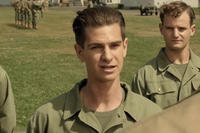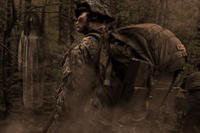In 1944, legendary Hollywood film director (and then-U.S. Army Major) WIlliam Wyler released "The Memphis Belle: A Story of a Flying Fortress," a 45-minute documentary showing what real air combat over Nazi-occupied Europe looked like for the men in the air. The film was a masterpiece, with one contemporary reviewer calling it "a thorough and vivid comprehension of what a daylight bombing is actually like for the young men who wing our heavy bombers from English bases into the heart of Germany."
Wyler and his crew risked their lives (and at least one died) to bring World War II to Americans back home. But there were technical problems with the film: A lab technician scratched the negative while processing it, and it became faded and dusty. Over time, the fading of film degrades it to the point where it begins to lose contrast and may one day be lost forever.
In 2016, filmmaker and self-described "amateur student" of World War II Erik Nelson ("Grizzly Man") was researching color footage in the National Archives when he came across Wyler's unused raw film. What he found was enough to make an entirely new film with that footage. In 2018, he not only released "The Cold Blue" using only Wyler's outtakes, but restored the original "Memphis Belle" movie, removing all the scratches and imperfections.
"You can't know American film without knowing about William Wyler," Nelson told Military.com in a recent interview. "I was riveted, always impressed by the 'Memphis Belle' and the film, a film Steven Spielberg says, and this is I think an exact quote, 'one of the most stunning things I have ever seen.'"
"Memphis Belle" documents the final mission of the titular B-17 bomber as it makes its 25th and final bombing mission over Europe. 'Memphis Belle' was only the third B-17 to finish its required missions, and the first to make it back to the United States. Life for bomber crews during the earliest days of the war was incredibly dangerous. Airmen were required to fly 25 missions to complete a tour, and the odds of surviving a full tour were 25%. Wyler flew on five missions aboard the Memphis Belle between February and May 1943.
The Army wanted to use a B-17 that had survived 25 missions on a war bond drive back home. While Wyler did document the Memphis Belle's final bombing run, he also captured footage from multiple combat missions for use in the final cut. One of the filmmaker's crew, Lt. Harold Tannenbaum, a World War I veteran, was killed in action during production.
"I was researching in the National Archives, looking for color footage of World War II, just color footage," Nelson recalled. "We discovered a box of outtakes from the 'Memphis Belle,' footage he shot that he didn't use in the movie; raw beautifully shot master footage. I realized that there was another film lurking in there, an art film -- as if William Wyler's footage was turned into a documentary today. A film that was shot in 1943, but created with the sensibility of a film today, and that became 'The Cold Blue.'"
Since Wyler's footage lacked sound, Nelson's team also added in audio tracks, as well as sounds from real B-17 bombers. The final production also included interviews from 8th Air Force veterans who flew over occupied Europe.
The results of Nelson's efforts were well-received. "The Cold Blue" currently enjoys a 100% rating on the aggregation website Rotten Tomatoes. Catherine Wyler, William Wyler's daughter, not only gave the project her blessing but also provided commentary on the DVD. Critics loved it, too: One reviewer said the "level of everyday heroism almost surpasses our capacity to absorb it."

Wyler's original footage suffered from the same technical issues as the original film. Two blue lines streaked many of Wyler's best shots. The color was faded, not nearly as vibrant as the early color films of the day. So when Nelson set out to make his new film, he also worked with Catherine Wyler to preserve and remaster the original. It required Nelson and the filmmakers to recut the entire original "Memphis Belle" from scratch using the newly restored footage.
"We did what anyone would do with a work of art. Imagine if the Mona Lisa had been scratched and had coal dust on it, and that was the version of the Mona Lisa that everyone had been seeing for a hundred years," Nelson said. "We removed the scratches and got rid of the coal dust. It looks better than the film ever did, even when Wyler premiered it to Franklin D. Roosevelt."
"The Memphis Belle: A Story of a Flying Fortress," "The Cold Blue" and a half-hour documentary about the making of the latter will air on TCM as part of the channel's Memorial Day military movie marathon. After the three documentaries, TCM will air William Wyler's Academy Award-winning classic "The Best Years of Our Lives," the 1946 story of three service members readjusting to life at home after the war. It will be the first time all four movies have aired together.
"William Wyler went to Europe, risked his life, made the 'Memphis Belle,' lost his hearing, came back and made 'The Best Years of Our Lives,' which is about the legacy of the war experience for men who flew in B-17s," Nelson said. "So this is William Wyler trying to sort out his ghosts and deal with his PTSD, which channeled directly into 'The Best Years of Our Lives.' It's almost an autobiographical film. ... It's not only an important event in film history; it's an important event in military history."
Viewers can catch the first in the series, "The Memphis Belle: A Story of a Flying Fortress" on TCM at 8 p.m. EDT on Sunday, May 26. It will be followed by "The Cold Blue" at 9, then "The Cold Blue: The Making of a War Documentary" at 10:45 and "The Best Years of Our Lives" at 11:15.
Keep Up With the Best in Military Entertainment
Whether you're looking for news and entertainment, thinking of joining the military or keeping up with military life and benefits, Military.com has you covered. Subscribe to the Military.com newsletter to have military news, updates and resources delivered straight to your inbox.

















